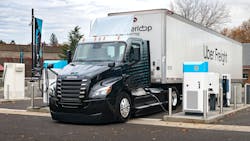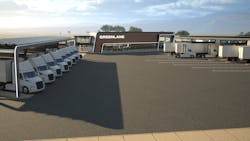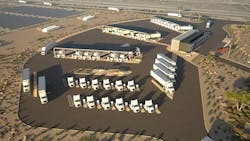DTNA’s Greenlane using Uber Freight data to build out trucking’s first EV corridor
Uber Freight and Daimler Truck North America's Greenlane commercial truck charging network endeavor are working together to determine the most efficient way to scale up heavy-duty battery-electric vehicle infrastructure and how to serve electric truck operations best, the companies announced.
Greenlane—a $650 million joint venture of DTNA, NextEra Energy Resources, and BlackRock—plans to use Uber Freight logistics network insights to help it plan out future public charging infrastructure along North American freight routes. The first charging corridors are planned for Southern California, followed by the Texas Triangle and the Northeast.
"Uber Freight manages $18 billion worth of freight each year for some of the world's largest brands, meaning we're sitting on a vast collection of historical data regarding how freight moves, various applications for different truck technologies, and the balance of supply and demand in the freight markets," Olivia Hu, head of autonomous trucking at Uber Freight, told FleetOwner. "This data provides a benchmark for how our customer's freight may move via electric trucks in the future."
See also: The good, the bad, and the difficult parts of electrification
Hu said that Uber Freight would provide Greenlane with "key insights to help inform, make data-driven decisions, and accelerate Greenlane's development and installation" of public charging infrastructure designed for heavy- and medium-duty EVs. Those insights, paired with Greenlane's data analysis, will help the charging company determine which freight corridors are the best candidates for early electrification and charging infrastructure.
"I am delighted that we will be working with Uber Freight to accelerate BEV adoption and help reduce the carbon footprint of freight distribution," Patrick Macdonald-King, Greenlane's chief executive, said. "Our national network of EV charging and hydrogen fueling stations, together with our Uber Freight collaboration, will make the electrification transition easier for shippers. Together, we will pave the way for a greener and more efficient future in logistics."
Both organizations also want to leverage Uber Freight's marketplace technology to explore creating in-app charging appointment scheduling, surface Greenlane charging stations, fuel card discounts, and more directly to carriers.
"Furthermore, leveraging the products and integrations built at Uber Freight, we will use our data and tech to further empower fleets and shippers with carbon accounting and load planning," Hu added.
Moving beyond depots to public charging infrastructure
"We've had a lot of customers take delivery of an eCascadia or two and be super happy with what they have and immediately think they want to take 50 or 100. Then they realize that they don't have a way to charge," O'Leary said during a roundtable discussion with industry media in January.
See also: It's time to focus on EV infrastructure
Nearly a year later, major fleets, such as Reyes Coca-Cola and Schneider National, have added dozens of eCascadias to their operations. Still, they use a depot-charging infrastructure model, where fleets plan their EV charging for vehicles that return to base or operate between two depots with on-site charging.
The most recent North American Council for Freight Efficiency study on fleet electrification found that trucking depots provide the best path for early electrification. Coca-Cola beverage rival PepsiCo, for example, is finding early success with its Sacramento depot electrification using early Tesla Semi models in California.
Depots with fewer trucks can be more easily electrified right now, according to the NACFE Run On Less Electric—Depot study that concluded this fall. "For those small energy depots, we're saying, 'Act now, go,'" Mike Roeth, NACFE executive director, told FleetOwner last month. "As for the large energy depots—and we're skipping over mediums stuck between small and large—but at the large energy depots, the trucks are getting more range. The Tesla Semi taught us that these trucks could do 400, 500 miles."
However, there is no nationwide electric charging infrastructure for commercial vehicles, which can be a barrier to fleets investing in electrification.
"Greenlane is designed to begin to tackle one of the greatest hurdles to the trucking industry's decarbonization: infrastructure," O'Leary said in April. "The nation's fleets can only transform with the critical catalyst of publicly accessible charging designed to meet the needs for medium- and heavy-duty vehicles."
Both Greenlane and Uber Freight leaders said that a U.S. charging network for commercial vehicles—built where they are most needed—would help more fleets fold EVs into their operations.
"Our joint vision is that ultimately, this collaboration helps the freight industry accelerate HD BEV adoption by addressing the unique challenges of sustainable logistics, starting with access to public charging infrastructure," Hu said. "In addressing the lack of public charging infrastructure for commercial vehicles, we alleviate one of the biggest anxieties and barriers to electrification for all fleets."
Hu declined to share how many EVs operate within its carrier partners' fleets but noted Uber Freight works with decarbonization early-adopter fleets and shippers to optimize EV operations.
"Uber Freight has been involved on the ground floor of the electrification of freight, collaborating with EV infrastructure leaders and EV truck developers, as well as advising shippers on how to incorporate electric capacity into their network," Hu said. "As part of this effort, we also just released a whitepaper revealing a roadmap for the thoughtful deployment and adoption of electric trucks at scale—uncovering insights regarding lane and region prioritization, facility enhancement recommendations for shippers, and more."
About the Author
Josh Fisher
Editor-in-Chief
Editor-in-Chief Josh Fisher has been with FleetOwner since 2017. He covers everything from modern fleet management to operational efficiency, artificial intelligence, autonomous trucking, alternative fuels and powertrains, regulations, and emerging transportation technology. Based in Maryland, he writes the Lane Shift Ahead column about the changing North American transportation landscape.



